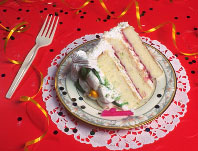Cakes and Pastry are prepared of various articles and are named accordingly. The essential articles required are eggs, butter, sugar and flour, for taste, plums, currants, almonds, candied peel of oranges or citron, for flavoring, any essence, nutmeg, cardamom, etc, for beauty cakes are made in ornamental moulds of different shapes and icing made of sugar and eggs are applied to the cakes in a decorative style.

The success of making cakes depends on the materials used, the manner the eggs are beaten, and the heat of the oven. The eggs should be quite fresh, the flour or plums or other materials should be quite dry. Never break the eggs and keep them for a long time. Break only as many eggs as required at a time to beat. Beat the whites and yolks separately in an earthenware, pot and not become watery if kept for a while and the yolks to a whitish cream. The butter and sugar should be stirred in an earthenware mortar or cup with a wooden roller till it becomes a smooth cream.
Pick and was the currants and plums, wipe them dry and stir them in the floor in which case it will prevent the plums from setting at the bottom. To prevent the cakes from being burnt, line the sides and bottom of the cake tins, with well buttered papers. Bake the cakes in an oven with moderate temperature. An over too high or low in temperature, will soil the cake. The required heat may be ascertained by dropping a little dry flour or cake batter on a buttered paper in the oven. To see whether the cake is baked inside poke a knife or a fork into it. It should come out clean. Without any batter sticking to it. In case the inside is not baked and the top is getting burnt place a pad of buttered paper on the top, without touching the cake. Always pour the cake batter to about 3/4 of the tin, thus allowing enough space for the cake to rise. Do not shake the tin in the oven, nor open the oven frequently.
| < Prev | Next > |
|---|
















